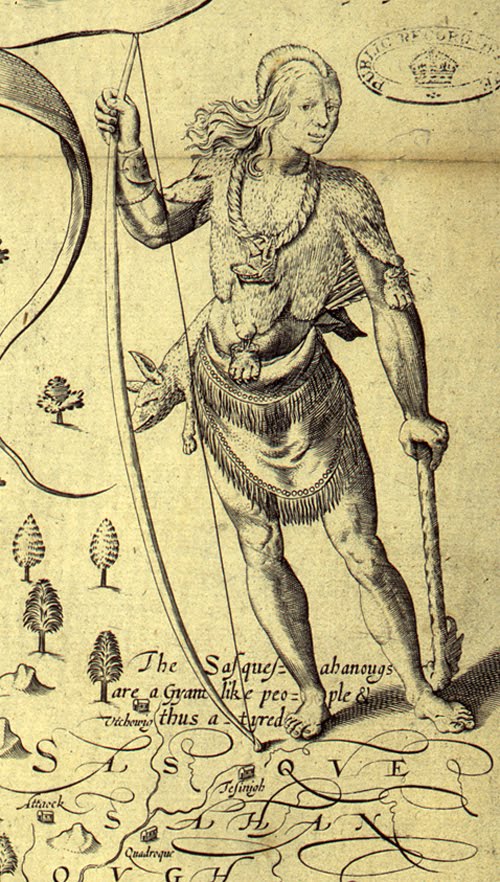“In the 15th century, only the Susquehannock Indians knew the paradise that was to become Essex.” — Essex, by Jackie Nickel
“In Captain John Smith’s map of 1606 is a picture of a Susquehannock warrior, with this curious description: ‘They seemed like giants to the English. Their language sounds like a voice in a vault. …One had a wolf’s head hanging in a chain for a jewel. His tobacco pipe three-fourths of a yard long prettily carved with a bird or a deer at great end, sufficient to beat out one’s brains. The calf of the chief’s leg was threefourths of a yard about, and all his limbs so proportionate, that he seemed the goodliest man we ever beheld. His hair on the one side was long, and the other shorne close like a coxe’s comb. His arrows were five-fourths long, headed with the splinters of a white chrystal stone, like a heart an inch broad and one and one-half inches long; these he wore in a wolf’s skin at his back for a quiver.'” —Maryland Historical Magazine
In describing the Susquehannock chief, Captain Smith said that “the calves of his legs were three-quarters of a yard about, and all the rest of his limbs so answerable to that proportion, and he seemed the goodliest man I ever saw.” “They seemed like giants, and were the strangest people in all these countries, both in language and attire; their language well becomes their proportions, sounding from them as a voice in a vault. Their attire is the skins of bears and wolves, some have cassocks made of bears’ heads, and skins that a man’s head goes through the skin’s neck, and the ears of the bear fastened to his shoulder, the nose and teeth hanging down his breast, another bear’s face split behind him, and at the end of their nose hung a paw, the half-sleeves coming to the elbows, where the neck of bears and the arms through the mouth, with paws hanging at their noses. One had the head of a wolf hanging in a chain for a jewel, his tobacco-pipe, three-quarters of a yard long, prettily carved, with a bird, a deer, or some such device at the great end sufficient to beat out one’s brains, with bows, arrows and clubs suitable to their greatness.” —A Brief History of Lancaster County

